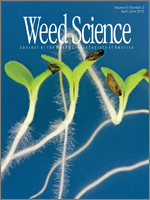Amicarbazone controls annual bluegrass in cool-season turfgrasses but physiological effects that influence selectivity have received limited investigation. The objective of this research was to evaluate uptake, translocation, and metabolism of amicarbazone in these species. Annual bluegrass, creeping bentgrass, and tall fescue required < 3, 56, and 35 h to reach 50% foliar absorption, respectively. At 72 h after treatment (HAT), annual bluegrass and creeping bentgrass translocated 73 and 70% of root-absorbed 14C to shoots, respectively, while tall fescue only distributed 55%. Annual bluegrass recovered ≈ 50% more root-absorbed 14C in shoots than creeping bentgrass and tall fescue. Creeping bentgrass and tall fescue metabolism of amicarbazone was ≈ 2-fold greater than annual bluegrass from 1 to 7 d after treatment (DAT). Results suggest greater absorption, more distribution, and less metabolism of amicarbazone in annual bluegrass, compared to creeping bentgrass and tall fescue, could be attributed to selectivity of POST applications.
Nomenclature: Amicarbazone; annual bluegrass, Poa annua L.; creeping bentgrass, Agrostis stolonifera L.; tall fescue, Festuca arundinacea Schreb.





